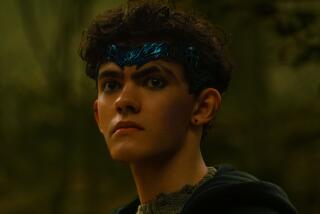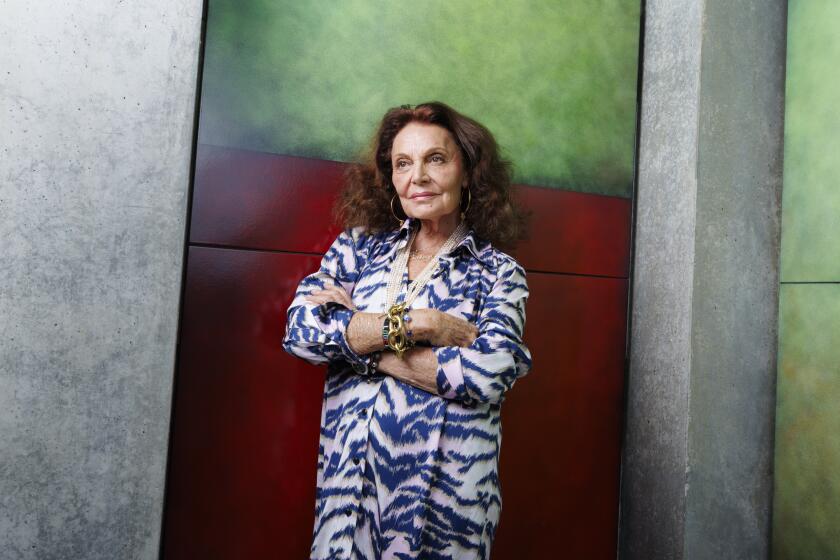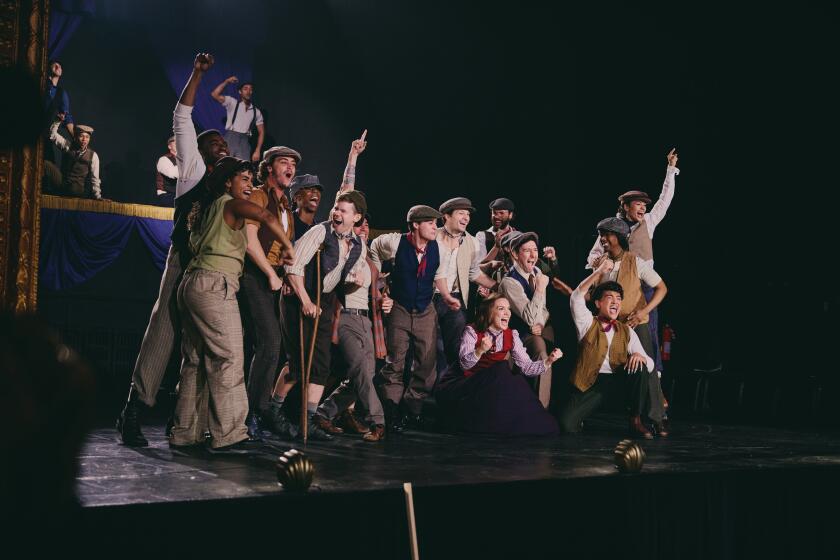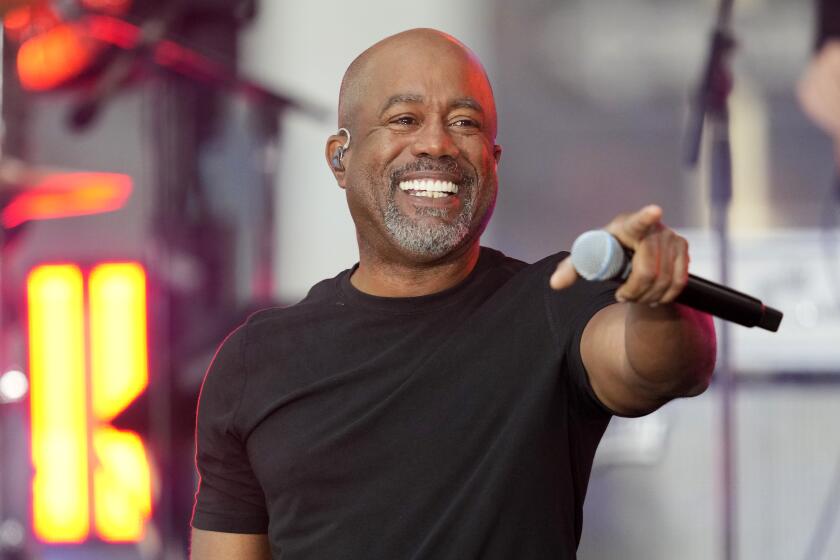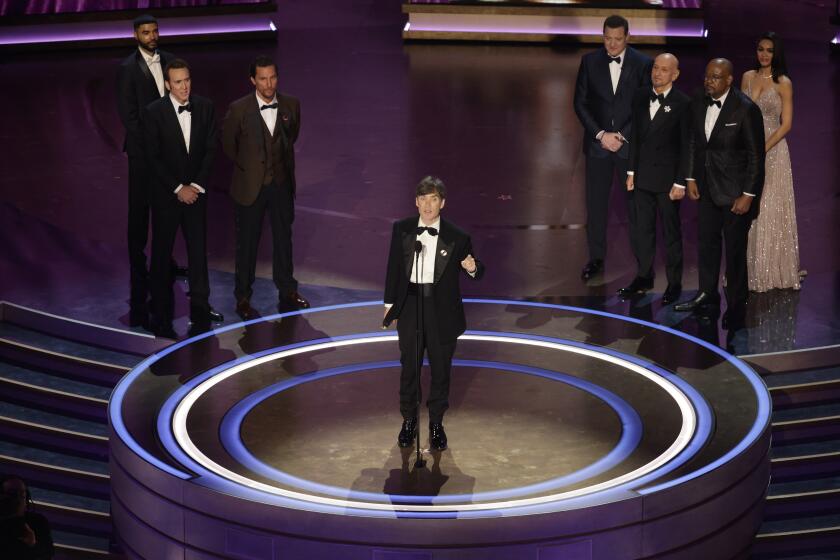‘Fiddler’s’ Leading Man : Starlight Conductor, in on Show’s Birth, Revives a Friendship
Over the last 24 years, countless conductors in 22 countries have struck up the band for “Fiddler on the Roof.” But only one, Starlight’s Milton Greene, was in on the birth of this internationally acclaimed American masterpiece.
“It was the biggest thrill of my life,” said Greene in a pre-performance interview at the Starlight Bowl. “I wanted to work with two living legends--Richard Rodgers and Jerome Robbins--and I did both. I was the music director for Richard Rodgers when he wrote his own lyrics for ‘No Strings.’ But getting to do the original Broadway production of ‘Fiddler on the Roof,’ with Jerome Robbins as the director and
choreographer, was definitely the highlight.”
Greene was music director and vocal arranger for “Fiddler” back in the early ‘60s, when the show was using the working title “Tevye.” Besides his duties in the pit, he passed judgment on auditioning cast members, arranged the songs and rehearsed the singers. Even before the show found its name--borrowed from a Marc Chagall painting--and well before producer Harold Prince was ready to take the show on the road for pre-Broadway tryouts, Greene knew he had a hit on his hands.
“I was very sure of it,” he said. “The music was good. The book was good. And we had Jerry Robbins. Ironically, I almost lost that show because of Robbins, even though Jerry Bock, the composer, was committed to me.”
It took rave reviews from show-biz greats Richard Rodgers, Adolf Green and Betty Comden to convince the doubting Robbins that Greene was the man for the job.
“Jerry Robbins didn’t know me then. I wasn’t as big as he was, and he wanted someone else to be his music director. But Jerry Bock said to me, ‘Who do you know that can recommend you to Robbins?’ and, once Robbins read the letters, he was satisfied.”
With Robbins’ blessing, it was pretty smooth sailing for Greene from then on. But backstage life among the “Fiddler” family was far from harmonious as the show began to take shape. The acrimony never subsided, in spite of the musical’s meteoric success on the Great White Way. A personality clash between the show’s star, Zero Mostel, and Robbins could be heard up and down Broadway.
“Zero Mostel and Jerry Robbins hated each other,” Greene said. “No one was happy in that show, and Zero was the catalyst. He was a bit crazy and very hostile, and we had a lot of factionalism in the company. People either sided with Zero or with Jerry.”
Greene, like almost everybody involved with the production, was intimidated by Robbins, whose slave-driving manner and emotional outbursts are well known in the business. But his disappointment with Mostel’s scene-stealing shticks and vicious pranks still plagues him today.
“Zero could have been the best Tevye of all, but he was more interested in getting laughs at anybody’s expense, so he cheapened the show,” Greene said. “And, since he was a big star, Jerry tolerated him. Bea Arthur, our Yentl, was fearful of Zero because he would squeeze her arm so tight when he held her, it would turn black and blue. No one could do a thing to control Zero.”
Audiences were apparently oblivious to the behind-the-scenes discord as “Fiddler on the Roof” went on to become one of the most celebrated musicals in history. Even a newspaper strike in Chicago, when the show came to town for pre-Broadway tryouts, couldn’t put a damper on this sure-fire moneymaker.
“ ‘Fiddler’s’ appeal is universal,” said Greene. “When we opened in Chicago, the houses were empty because there were no reviews. But the news spread even without the papers. Just by word of mouth, we soon started to sell out. And, when we got to New York, the critics loved it, and the show was set.”
“Fiddler on the Roof” is a bittersweet tale about Jewish life in Russian villages at the turn of the century, when ancient traditions clashed with contemporary realities and life was as precarious as a fiddler on a roof. So how does Greene explain the scenario’s international appeal?
“A Japanese star came to New York to learn the show when it was being produced in Japan,” Greene said, “and he told me, ‘This is not a Jewish show, it’s too Japanese.’ We found out it’s everybody’s show.”
The seamless blend of spellbinding story, excellent songs and brilliant dancing didn’t hurt the show’s appeal, either.
“Fiddler” returns tonight to San Diego for a two-week run at the Starlight Bowl. And, for the first time since Greene worked with the original company, the maestro will be in the pit to conduct.
“I’m feeling a little deja vu, “ he said. “I played over 2,000 performances of ‘Fiddler,’ and I made the cast album of the show, but I haven’t done it since because I was always working on new shows. It’s only since I’ve been here at Starlight for four years that I do any revivals.”
The familiar score may sound a little different to purists, but Greene chalks that up to evolution and economics.
“When you do it on Broadway, the tempo is slower. I know our cast album was slower than we’re playing it here. But, once the dancers get comfortable with the music, the choreographers start to push them faster, and there’s a metamorphosis. I’ll go to a certain limit, but then I just tell them it’s too fast.”
The 30 or so musicians accompanying a Broadway production have been whittled down to about 23 for this staging. However, as Greene noted, that’s still an improvement over typical regional productions.
“Most places, you won’t get more than 10 in the orchestra, so 23 is pretty good,” said Greene.
Jerry Bock and his lyricist, Sheldon Harnick, came up with a virtual treasure chest of songs for “Fiddler.” But, as Greene pointed out, most of them were cranked out on the road.
“There were lots of changes once we began the road trip. We must have taken out about 10 songs--and put in 10 songs. ‘Do You Love Me?’ was added in Washington, about five weeks into the tryouts.
“And Robbins wasn’t sure of himself when it came to the choreography either. The dancers had to learn three different versions,” Greene said. “All three were very tricky and difficult to dance, so the dancers were a wreck. Invariably, he went back to his first version, too. Jerry exploits the dancers’ talents to the nth degree. It’s a very physical show.
“But Jerry didn’t know how to end the show, and he wasted a lot of time trying to choreograph a dance with pots and pans for the Anatevka scene, which never worked. Finally, he asked us for ideas about it, but we were all too afraid to voice an opinion.”
For Starlight’s production, the first “Fiddler” in six years for the Balboa Park troupe, the atmosphere will be a lot more low-key, Greene acknowledged. A pair of “Fiddler” veterans, Bob Carroll and Bess Meisler, will play the impoverished milkman and his wife. Meisler dates back to the Broadway production, where she starred as Golde when Herschel Bernardi was Tevye. Frank Coppola, with more than 50 stage productions to his credit, will take on the dual role of director-choreographer.
Once, during Greene’s four years with Starlight, he took a hiatus to do another Broadway show. But the project fell through for lack of backers, and Greene was back in time for another season. Is there another “Fiddler” in his future?
“No. I have no ambition for Broadway any more, and L. A. gets the touring shows,” he said. “So they don’t need a music director. I want to keep on coming back to Starlight.”
Musician Gary Pack said that’s fine with the Starlight orchestra.
“Milton Greene has the perfect balance of qualities to make it all happen,” Pack said, “and, like any good leader, he tries to make his presence felt as little as possible.”
More to Read
The biggest entertainment stories
Get our big stories about Hollywood, film, television, music, arts, culture and more right in your inbox as soon as they publish.
You may occasionally receive promotional content from the Los Angeles Times.


